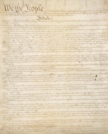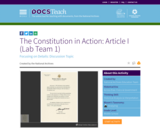
This 3-room video tour of the U.S. Capitol, featuring the Crypt, Rotunda, and National Statuary Hall.
- Material Type:
- Activity/Lab
- Lesson
- Author:
- OER LIBRARIAN
- Date Added:
- 06/02/2022

This 3-room video tour of the U.S. Capitol, featuring the Crypt, Rotunda, and National Statuary Hall.

In this activity students will analyze documents that span the course of American history to see examples of "checks and balances" between the legislative, executive, and judicial branches in action. Students will then match the documents they have examined with an appropriate description of the branches of government involved in the action.

The nation’s founders believed Congress to be the fundamental institution of the federal government, since it is the body that most closely represents the people. The framers of the United States Constitution began by creating Congress. Then they established the other two branches of government—the executive branch and the judicial branches.The Constitution gives each branch distinct powers, but it makes sure that the three are in competition. Each branch has its own ways to check and balance the powers of the other two. The separation and balance of powers has contributed to the government’s enduring vitality, providing order and stability while allowing flexibility for adaptation and change.

In this activity students will analyze the Oaths of Senators for the Impeachment Trial of William Jefferson Clinton and identify how the document demonstrates content contained within Article I, sections 1-7 of the Constitution in action.
This activity is designed to prepare students for the Constitution-in-Action Lab at the National Archives in Washington, DC. It is a part of a package of activities associated with the lab experience.

In this activity students will analyze the Declaration of Intention for Albert Einstein and identify how the document demonstrates content contained within Article I, sections 8-10 of the Constitution in action.
This activity is designed to prepare students for the Constitution-in-Action Lab at the National Archives in Washington, DC. It is a part of a package of activities associated with the lab experience.

Of the three branches of our government, many believe that the most important is the one directly elected by "We the People": the legislative branch, represented by the two houses of the U.S. Congress at the Capitol building. Join a group of middle schoolers on a tour of Washington, D.C. as they learn about the Constitution and what it means to be "We the People." The "We the People" videos are produced in collaboration with the U.S. Capitol Historical Society.